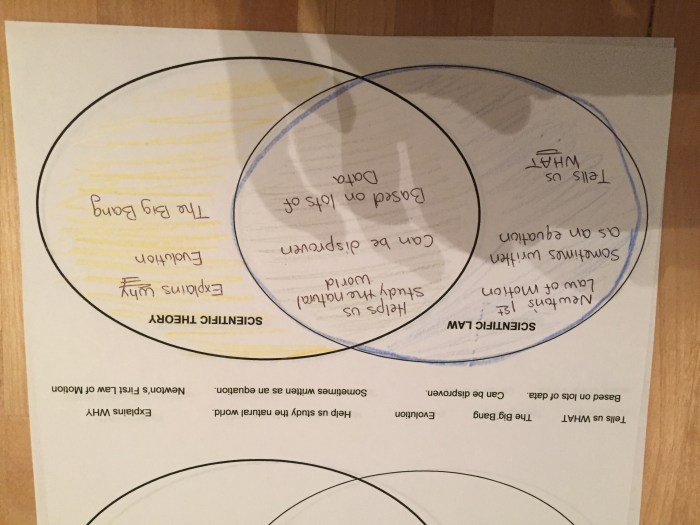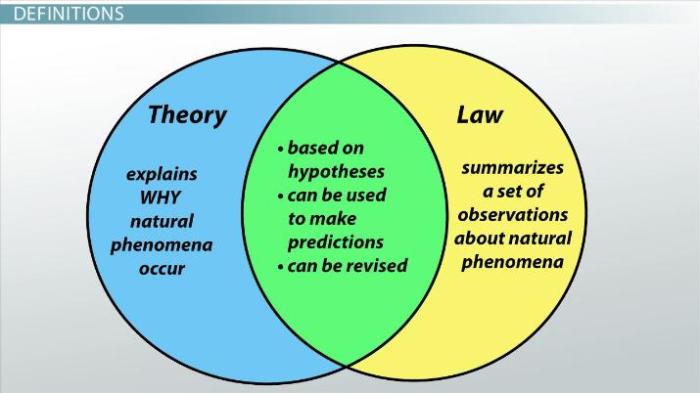The theory and law venn diagram takes center stage as we delve into the intricate relationship between theory and law. Brace yourself for a journey where legal concepts and philosophical underpinnings intertwine, promising a reading experience that is both enlightening and captivating.
In this comprehensive guide, we will explore the definitions and roles of theory and law, unravel the various types and sources that shape them, and witness firsthand how they influence each other’s development. Through engaging examples and thought-provoking discussions, we will uncover the challenges and benefits of using theory to inform law and vice versa.
Venn Diagram: Theory and Law

A Venn diagram is a graphical representation of the relationships between different sets. It can be used to illustrate the overlap between theory and law.
In a Venn diagram, each set is represented by a circle. The overlapping area between the circles represents the elements that are common to both sets. The non-overlapping areas represent the elements that are unique to each set.
Theory and Law
In the context of theory and law, the Venn diagram can be used to illustrate the following relationships:
- Theory Only:This area represents the elements of theory that are not found in law. These may include abstract concepts, untested hypotheses, or speculative ideas.
- Law Only:This area represents the elements of law that are not found in theory. These may include specific rules, regulations, or statutes.
- Theory and Law:This area represents the elements that are common to both theory and law. These may include general principles, concepts, or ideas that are found in both disciplines.
Theory

A theory is a set of interrelated concepts, definitions, and propositions that present a systematic view of a phenomenon. In law, theories play a crucial role in understanding the underlying principles and values that shape legal systems and legal decision-making.
Legal theories provide frameworks for analyzing and interpreting laws, predicting legal outcomes, and developing new legal doctrines. They offer a lens through which we can examine the complexities of the legal system and its impact on society.
Types of Legal Theories
There are various types of legal theories, each with its unique focus and approach. Some of the most prominent include:
- Natural law theory:Argues that laws are derived from universal moral principles that exist independently of human will or societal conventions.
- Legal positivism:Views law as a set of rules created and enforced by the state, with no necessary connection to morality.
- Critical legal studies:Examines the role of power, ideology, and social context in shaping the law and legal institutions.
- Feminist legal theory:Focuses on the experiences and perspectives of women and marginalized groups within the legal system.
- Economic analysis of law:Applies economic principles to legal decision-making, arguing that laws should be designed to maximize efficiency and social welfare.
Influence of Theory on Law Development, Theory and law venn diagram
Legal theories have a profound influence on the development of laws. By providing a framework for understanding the purposes and principles of law, theories guide the interpretation of statutes, the creation of new legal doctrines, and the resolution of legal disputes.
For example, natural law theory has influenced the development of human rights laws, while legal positivism has shaped the modern administrative state. Feminist legal theory has led to the recognition of gender discrimination as a legal wrong, and critical legal studies has challenged traditional notions of objectivity and neutrality in the law.
Law

Law refers to a system of rules and regulations that govern a society or organization. It establishes standards of conduct and provides mechanisms for enforcing those standards. Law is closely related to theory, as it often reflects the underlying values and principles of a society.
The sources of law can vary, including statutes enacted by legislative bodies, court decisions, regulations issued by administrative agencies, and customs or traditions that have gained legal recognition. Each source of law carries a different level of authority, with statutes generally considered the most authoritative.
Influence of Theory on Law
Theory can significantly influence the development and interpretation of laws. For example, theories of justice and fairness have shaped constitutional protections and principles of due process. Similarly, economic theories have influenced laws governing trade, taxation, and labor relations.
Interplay of Theory and Law

Theory and law are intertwined concepts that shape and influence each other. Theory provides a framework for understanding and interpreting the law, while the law serves as a practical application of theoretical principles. This interplay between theory and law has a profound impact on legal outcomes.
Challenges and Benefits of Using Theory to Inform Law
Using theory to inform law offers several benefits. It provides a systematic approach to legal analysis, helping to identify the underlying principles and values that guide legal decision-making. Theory can also help identify potential gaps or inconsistencies in the law, leading to more comprehensive and coherent legal frameworks.
The theory and law venn diagram depicts the intersection of theoretical and legal concepts. Just as a 420 sailboat comprises various components, from its hull to its sails ( parts of a 420 sailboat ), the venn diagram illustrates the interplay between theory and law, highlighting their distinct yet interconnected aspects.
However, challenges also arise when using theory to inform law. Different theories may lead to different interpretations of the law, potentially creating uncertainty and inconsistency. Additionally, the application of theory to real-world legal problems can be complex and challenging, requiring careful consideration of the specific facts and circumstances.
Challenges and Benefits of Using Law to Inform Theory
Conversely, using law to inform theory can provide valuable insights into the practical implications of theoretical concepts. By examining how legal principles are applied in real-world cases, theorists can refine and develop their theories to better reflect the complexities of legal practice.
Challenges also arise when using law to inform theory. Legal outcomes are often influenced by a variety of factors, including political, social, and economic considerations. This can make it difficult to isolate the impact of theory on legal outcomes.
Examples of How the Interplay of Theory and Law Has Shaped Legal Outcomes
The interplay of theory and law has had a significant impact on legal outcomes throughout history. For example, the natural law theory, which posits that certain rights and duties are inherent in human nature, has influenced the development of human rights law and constitutional protections.
Another example is the economic theory of law, which analyzes the law through the lens of economics. This theory has been used to justify legal reforms aimed at promoting economic efficiency and maximizing social welfare.
Examples

Laws Influenced by Theory
- Law:Same-sex marriage legalization
- Theory:Gender equality theory
- Influence:The theory of gender equality influenced the development of laws that legalized same-sex marriage by challenging traditional notions of marriage and family.
- Law:Criminalization of hate speech
- Theory:Hate speech theory
- Influence:Hate speech theory provided the conceptual framework for laws that criminalize speech that incites hatred or violence against specific groups.
Theories Influenced by Law
- Theory:Legal realism
- Law:Common law
- Influence:The development of common law through judicial decisions influenced the emergence of legal realism, which emphasizes the role of judges in shaping the law.
- Theory:Feminist legal theory
- Law:Anti-discrimination laws
- Influence:Anti-discrimination laws provided empirical evidence for feminist legal theory, which critiques the gender bias in the legal system.
FAQ Overview: Theory And Law Venn Diagram
What is the purpose of a theory and law venn diagram?
A theory and law venn diagram provides a visual representation of the overlap and distinction between theory and law, helping us understand their relationship and influence on each other.
How does theory influence the development of laws?
Theory provides a conceptual framework and principles that guide the creation, interpretation, and application of laws, shaping their content and scope.
What are the challenges of using theory to inform law?
Challenges include ensuring that theories are relevant, applicable, and not overly abstract, as well as balancing theoretical considerations with practical realities and policy concerns.
